The Australian Guide to Geotextile Fabrics
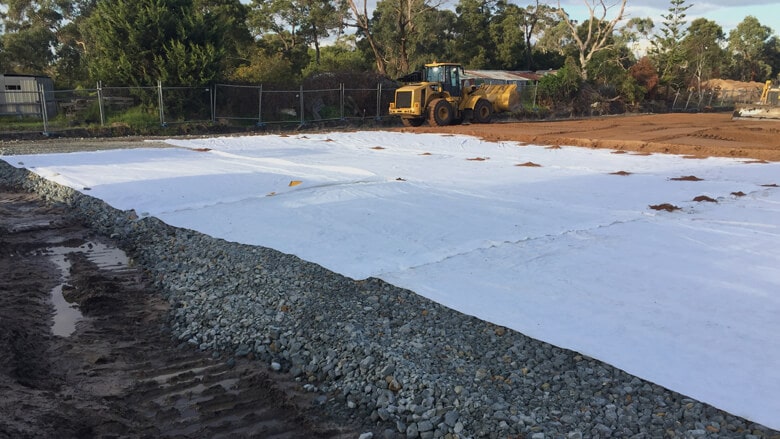
The main types of geotextiles and how to select the right one for your project
What are geotextiles?
Geotextiles are synthetic fabrics that are used in a range of different construction, drainage and landscaping applications.
Supplied on long rolls, these fabrics are often used to help manage soft or challenging soil types that aren’t suitable for building roads or pavements. By adding strength and stability to the subsoil layers, geotextiles help to minimise natural earth movement, cracking and sinking by providing a stable, long term foundation.
Used in everything from roads to railways, drainage and pipeline projects, landscaping and more, geotextiles come in a wide variety of styles, however, the most common are woven and non-woven fabrics.
Geotextile fabrics: woven vs non-woven
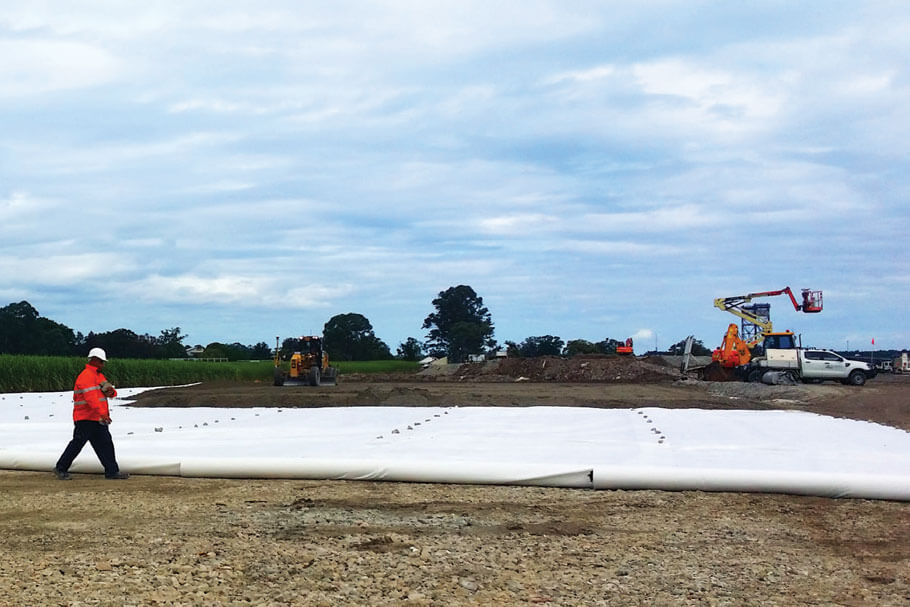 Some of the most popular types of geotextile fabrics are woven and non-woven types. Both of these are permeable, meaning they allow moisture to pass through them, helping with drainage and filtration.
Some of the most popular types of geotextile fabrics are woven and non-woven types. Both of these are permeable, meaning they allow moisture to pass through them, helping with drainage and filtration.
Woven and non-woven geotextiles have different permeability rates, meaning engineers and designers can select different fabrics to adjust water flow rates depending on the project.
They also have different properties due to their construction: woven fibres lock together and provide more tensile strength, as opposed to non-woven fabrics which aren’t as strong, but offer better drainage and filtration properties.
Made from synthetic fabrics like polyester and polypropylene, woven geotextiles are constructed from intertwined yarns, whereas non-woven types are needle-punched, creating a perforated surface.
Main uses of woven geotextiles
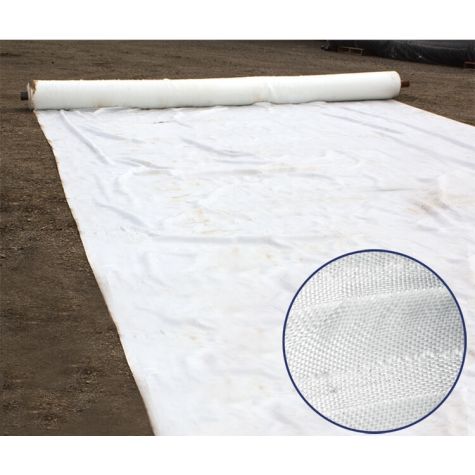
Woven geotextiles have excellent tensile strength characteristics, making them great for stabilising the base course underneath roads and pavements, and reinforcing difficult soil types.
Woven fabrics also offer excellent creep resistance which results in higher long term design strengths, plus they provide exceptional soil confinement resulting in superior load distribution.
Woven geotextiles provide a cost-effective solution for reinforced soil structures including:
- Embankments and slopes
- Stabilisation projects
- Reinforcing pavements and roads
What are non-woven geotextiles best for?
With their good permeability, non-woven geotextiles are frequently used in situations where excellent drainage is required, for example under sports fields and in landscaping situations. Their higher permeability means moisture drains through them at a faster rate compared to woven fabrics.
Non-woven geotextiles made from polyester are resistant to alkalis and acids, meaning they are long-lasting when installed under the soil. Suitable for use in road and rail work, separation, drainage, protection and filtration works, these fabrics are often installed in parks, playgrounds, landfills, on batters and slopes, behind retaining walls and more.
Some of the top uses for non-woven geotextiles include:
- Pavement stabilisation
- Subgrade or subsoil separation
- Slope stabilisation
- Liner protection
Environmental benefits of geotextiles
By providing strength, stability and a long design life, geotextiles can contribute to reducing the carbon footprint of your construction project.
This is because geotextiles offer a long term solution, heavily reducing the requirements for ongoing maintenance.
For example, in a road pavement project, geotextiles can offer both strength and stability that increases the lifespan of the road. This means fewer maintenance costs over time and less need for heavy earthmoving machinery to fix cracks and potholes.
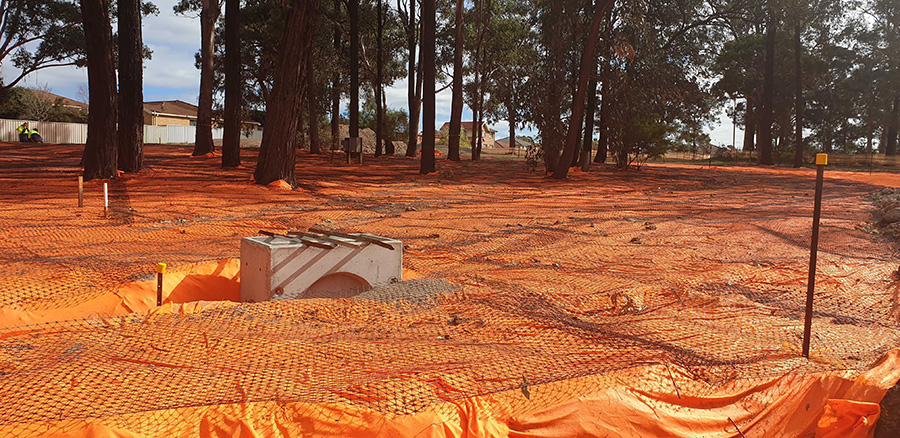 However, the most significant contribution to lowering a project’s carbon footprint comes from the way that geotextiles reduce the need for heavy base courses like gravel and coarse fill.
However, the most significant contribution to lowering a project’s carbon footprint comes from the way that geotextiles reduce the need for heavy base courses like gravel and coarse fill.
Whilst a minimal layer is often still needed, using geotextiles for reinforcement and stability heavily reduces the amount of base material required to stabilise the pavement. Reducing the number of trucks required to transport this fill also reduces the reliance on upstream resources such as aggregate quarrying and diesel-emitting transport.
Additionally, using geotextiles can mean less site preparation. This is because traditional heavy excavation followed by adding tons of granular fill produces significant CO2 emissions, not to mention more time on site. Therefore, choosing geotextiles means you’re cutting down the project time whilst also adding to the long term design life of the pavement.
5 Top applications for geotextiles
1 Separating different materials
Geotextiles can separate two different materials such as soil and rock fill. This provides a barrier that stops the fill from eventually sinking into the earth by covering the underlying soil with a protective geotextile layer.
2 Stabilisation
Geotextiles help to add stability to soft soils and damp, compressible base courses. By adding a layer of geotextile, water can seep from the soft soil to the draining material. As a result, it consolidates the base layer, strengthening it and making it more reliable.
3 Reinforcement
In reinforcement applications, a geotextile provides strength to steep slopes, retaining walls and embankments. Forces are transferred to the geotextile rather than into the ground, preventing sloped sites from slipping, crumbling or eroding.
4 Filtration
Because they are permeable, geotextiles can be used as a filtration layer that allows moisture to seep through at a controlled rate. This helps to prevent erosion by slowing down the flow of water whilst preventing soil and fine particles from passing through.
5 Drainage
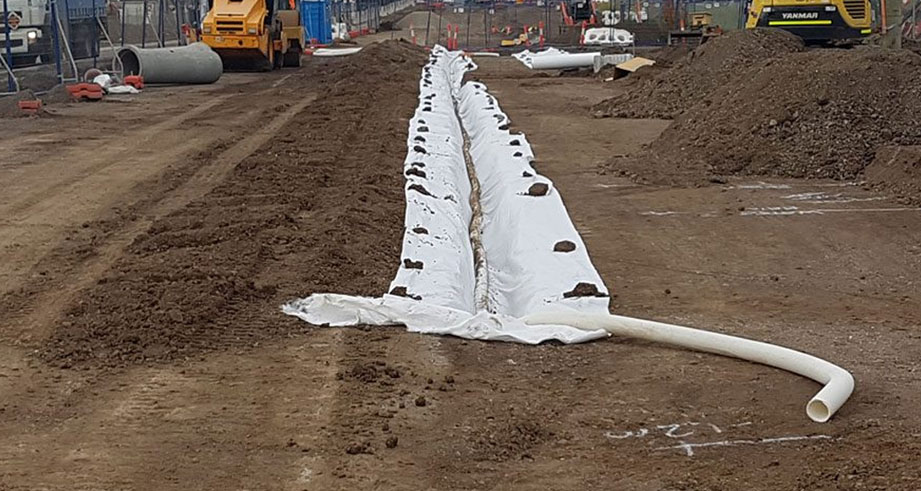 Geotextile fabrics can help to consolidate water and transport it along a designated path, often using the plane of the fabric to create a wicking effect.
Geotextile fabrics can help to consolidate water and transport it along a designated path, often using the plane of the fabric to create a wicking effect.
Geotextile selection chart for road applications
When selecting geotextiles for road applications, most Australian road authorities have specific criteria that need to be met. This includes compliance with certain manufacturing and testing requirements, as well as minimum strength and filtration limits for different applications.
When using a geotextile in a road application, the soil type, the rock fill and the geotextile itself will interact to produce different results, so getting the balance of these three things right is critical.
It’s also important to note that different site conditions need different solutions, so a steep embankment would have different geotextile needs to flat pavement. Understanding the application and the geotechnical forces at play is key to a successful long-term installation.
Strength ratings
Woven and non-woven geotextiles are broken into classes based on their strength, ranging from class A at the low end through to extremely strong class E geotextiles. Usually, the class would be specified for a project, and this will then determine the size and amount of rock fill to be used.
Soil type
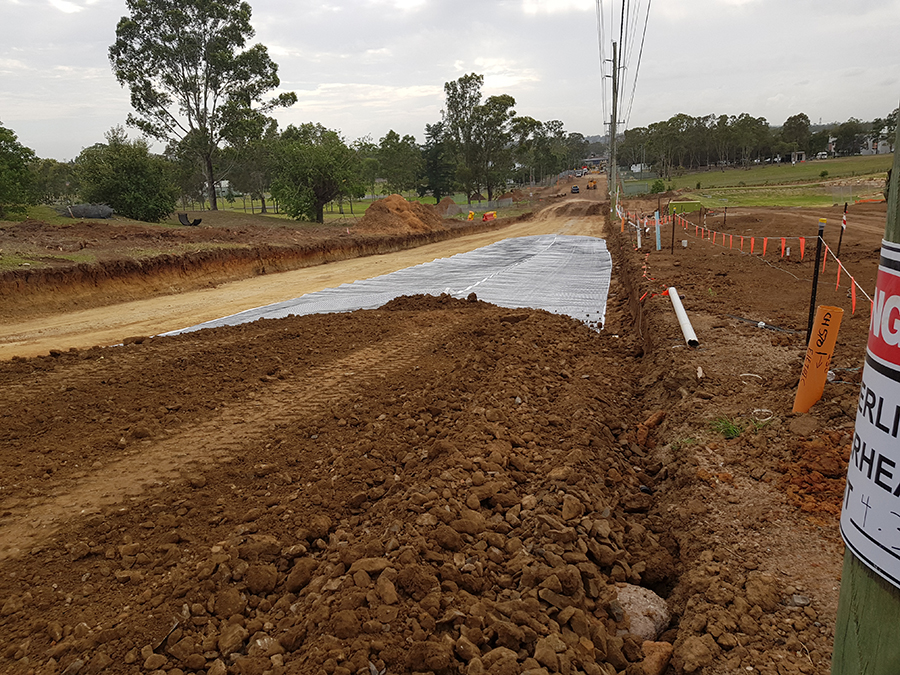 The soil type also has a bearing on which class of geotextile is appropriate, however, soils can generally be classified as either soft or firm. When working with soft soils, typically you need a stronger, thicker geotextile to ensure the fill being placed on top doesn’t puncture through. For separation on firmer soils, a thinner geotextile is typically fine as it will not be stretching and moving with loads placed on top.
The soil type also has a bearing on which class of geotextile is appropriate, however, soils can generally be classified as either soft or firm. When working with soft soils, typically you need a stronger, thicker geotextile to ensure the fill being placed on top doesn’t puncture through. For separation on firmer soils, a thinner geotextile is typically fine as it will not be stretching and moving with loads placed on top.
Fill size
Once you have worked out what size rock fill will be available for your project, you can then select the geotextile class that will be needed. The larger and heavier your rock is, the thicker the geotextile will need to be to ensure it doesn’t puncture. For pavement stabilisation, rock fill sizes generally fall between 20mm and 150mm, however can be up to 400mm in diameter.
The below chart offers a simple indication of the type of geotextile required for different projects, however, accurate selections should always be made by an engineer and should reference the requirements of the local road authority. This is a simplified table from NSW RMS R63, and QLD TMR MRTS27.
Geotextile Selection Chart
| Rock Size | Soft Soil | Firm Soil |
| 0-40mm | Class C | Class A |
| 40-75mm | Class C | Class B |
| 75-200mm | Class D | Class C |
| 200-400mm | Class E | Class D |
| 400-600mm | Class E | Class E |
Get advice on selecting woven and non-woven geotextiles
The Jaybro geosynthetics team is here to support our customers with advice, technical information, engineering support and fast delivery, Australia-wide. Contact us to order the right geotextiles to make your project a success.
 Sign In
Sign In 

